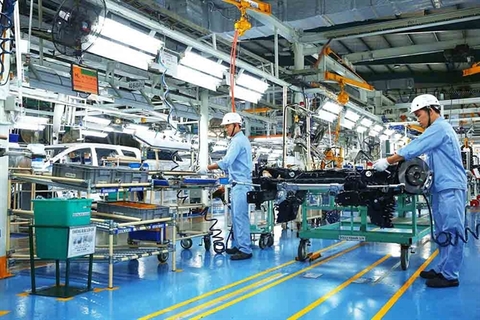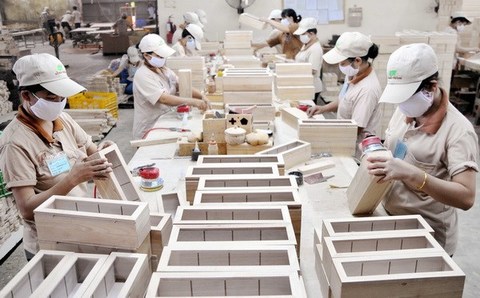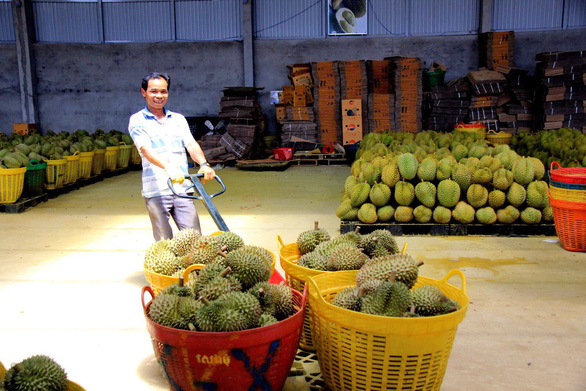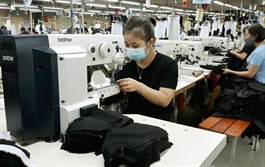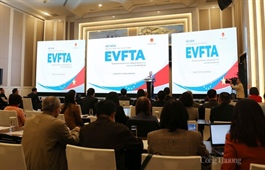CPTPP improves Vietnam’s position in int’l integration: official
CPTPP improves Vietnam’s position in int’l integration: official
Despite continued concerns over the contents of the Comprehensive and Progressive Agreement for Trans-Pacific Partnership (CPTPP), the achievements of the deal are remarkable in terms of the enhancement of Vietnam’s international economic integration, Luong Hoang Thai, head of the Multilateral Trade Policy Department under the Vietnamese Ministry of Industry and Trade, said at a conference in Hanoi on Monday.
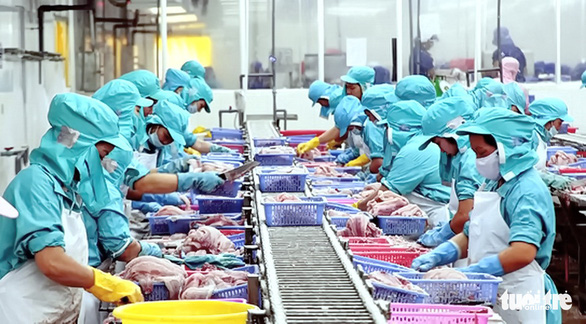
At the conference, which was hosted by the Multilateral Trade Policy Department alongside Cong Thuong (Industry and Trade) Magazine in order to review the three-year implementation of the CPTPP, Thai hailed the free trade accord as a milestone of the country’s integration process.
As an example of such integration, Thai noted that the European Union has prioritized the establishment of ties with CPTPP member countries in the Asia-Pacific region, with Japan, Singapore, and Vietnam already having signed free trade agreements with the bloc.
Thai also pointed out the CPTPP’s current success will likely springboard its future growth.
“After the CPTPP came into force, many countries, including the UK, began showing interest in joining the bloc,” Thai said, adding that other future potential signees might include South Korea and China.
CPTPP boosts Vietnamese exports
In its first year alone, the CPTPP has helped Vietnam boost its exports to Canada and Mexico by nearly 30 percent, as well as helped to maintain the Southeast Asian country's overall trade surplus at approximately US$1 billion.
In total, Vietnam exported $45.7 billion worth of products to other CPTPP markets in 2021, up 18.1 percent from 2020.
The nation earned $45.1 billion in export revenue from the bloc and imported $43 billion in goods from CPTPP countries in January-October this year, up 22.1 and 16.26 percent, respectively, year on year.
In the Americas specifically, Vietnam shipped over $12 billion worth of products to four countries and imported just $1.6 billion from the same region last year, allowing it to boost its trade surplus with the region to $10.4 billion.
This included sending $5.3 billion and $4.6 billion in exports to Canada and Mexico, respectively. For Canada, this was a 75 percent increase over the period before the CPTPP ratification. For Mexico, the rise was a whopping 104 percent.
The other two countries in the Americas with whom Vietnam had impressive trade success were Peru and Chile.
Vietnam’s exports to Chile, another CPTPP member country, surged to $560 million last year, an 85-percent year-on-year climb.
The Southeast Asian country’s exports to Peru, which has yet to ratify the CPTPP, hit $1.7 billion, a 63-percent jump from 2020, according to Dau Tu (Investment) newspaper.
At the conference, Nguyen Hoai Nam, deputy general secretary of the Vietnam Association of Seafood Exporters and Processors (VASEP), said “the CPTPP has brought many benefits to Vietnam, particularly its seafood industry, which increased its market share in CPTPP member countries from 25 to 30 percent.”
Nam noted that much of this success is due to the tax incentives and loose origin restrictions afforded by the CPTPP.
There are also many industries that are indirectly benefiting from the trade deal.
According to Do Thi Thu Huong, a member of the executive board of the Vietnam Electronic Industries Association, Vietnamese electronics enterprises, which do not directly export products, are benefitting from more robust supply chains and outsourcing markets.
The participation in supply chains and the utilization of export advantages ushered in by the CPTPP has proved especially effective in helping enterprises adjust their production capacities, integrate into the global supply chain, improve governance, and access markets in a more professional manner.
Nguyen Hong Hiep, director of internal affairs-communications-external relations at PAN Group, a local agriculture and food firm, said his company had made use of the CPTPP to increase its access to Japanese, Canadian, and Australian markets.
Pham Thi Ngoc Minh, a representative of the Agency of Foreign Trade under the Ministry of Industry and Trade, asked that enterprises adhere to traceability regulations in the CPTPP and invest more in the human resources and document storage infrastructure required to the origins of their products.
Bui Tuan Hoan, head of the American Market Division under the Ministry of Industry and Trade’s European-American Market Department, said that enterprises still face difficulties, such as rising logistics and transport costs; and strict requirements on quality, food safety, and employment.
All of these challenges could hinder growth.
The Ministry of Industry and Trade will coordinate with localities to resolve such difficulties in order to cement the position of Vietnamese brands in the global market.
The CPTPP is a new-generation free trade agreement with 11 members, including Australia, Brunei, Canada, Chile, Japan, Malaysia, Mexico, New Zealand, Peru, Singapore, and Vietnam.
The deal aims to lower barriers to trade in goods and services between member countries.
It is one of the largest free trade areas in the world by gross domestic product (GDP), along with the U.S.-Mexico-Canada Agreement, the European Single Market, and the Regional Comprehensive Economic Partnership.
The combined economy of 11 CPTPP countries represents 13.4 percent of global GDP, approximately $13.5 trillion.
The agreement was signed on March 8, 2018 in Santiago, Chile. It went into effect on December 30, 2018 for its six founding countries, including Mexico, Japan, Singapore, New Zealand, Canada, and Australia.
Vietnam ratified its membership in the CPTPP on January 14, 2019.
The UK, China, Taiwan, South Korea, Ecuador, and Costa Rica have filed applications to join the CPTPP.




